What To Visit In Vietnam? Discover Top 06 Best Temples In Vietnam
Friday, July 26, 2024
Places to visit & things to do

Vietnam is renowned not only for its stunning landscapes and natural beauty but also for its magnificent and sacred temples. These architectural marvels offer a deep insight into the country’s rich cultural and spiritual heritage. If you are wondering what to visit in Vietnam, let Autour Asia guide you through the top best Vietnamese temples in this article.
Table of Contents
I. Introduction about Vietnamese temple
Vietnamese temples, known as "đền" in Vietnamese, are an integral part of Vietnam's cultural and spiritual landscape. These temples are also a type of religious architecture aimed at worshipping a hero or historical figures revered as gods, famous people who are talented or have great contributions in history... so temples are also closely associated with spirituality in Vietnamese and are built everywhere. Ancient temples are often chosen in locations considered sacred, often quite independent and located on a large area of land surrounded by quite quiet and majestic landscapes of forests, mountains or fields. The construction of temples in Vietnam reflects the Vietnamese people's tradition of gratitude, honouring those who have made significant contributions to their homeland and country.
Many tourists when coming to Vietnam often confuse these spiritual sites such as pagoda, communal house, palace, temple in Vietnam. So how to distinguish them? You can refer to some of our following suggestions :
- The pagoda (Chùa in Vietnamese) is a place for Buddhist activities and propagation, a place for monks and nuns to live, practice and preach Buddhism. Everyone, including believers and non-believers, can visit, listen to Buddhist teachings or practise Buddhist rituals. In some places, pagodas are also places to keep relics and bury great masters.
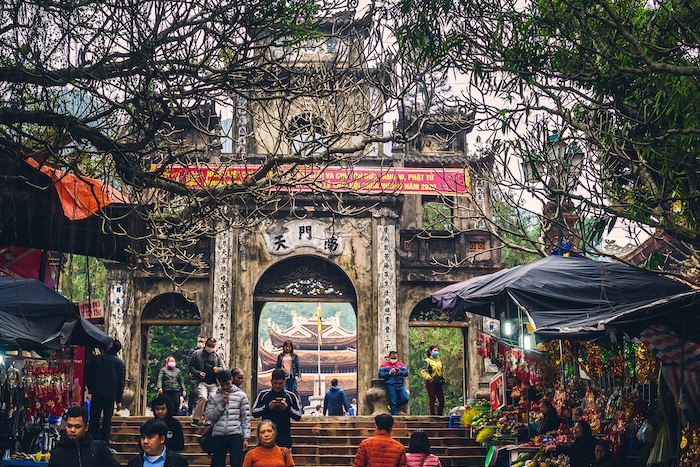
- The temple (Đền in Vietnamese) is an architectural structure built to worship historical figures revered as gods. In Vietnam, the most common are temples built to commemorate the merits of heroes who have contributed to the country or the merits of an individual to the locality, built according to folk legends.
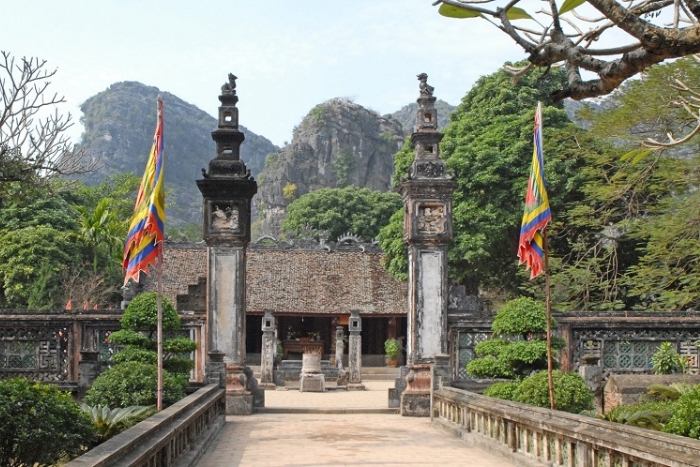
- The village communal house (Đình in Vietnamese) is a place to worship the village's tutelary god (people who have made great contributions to the village) and is also a meeting place for villagers. The village communal house is considered a centre of cultural activities closely linked to the community and is a characteristic of the Vietnamese rice civilization. That is also the reason why the village communal house always has a very large and spacious yard.
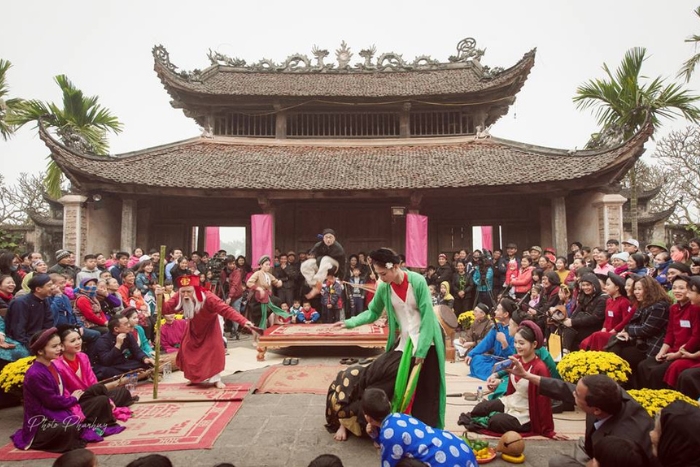
Take a look at: Best pagodas in Vietnam
II. Top most famous temples in Vietnam
1. Hanoi Temple of Literature
- Address: 58 Quoc Tu Giam Street, Van Mieu, Dong Da district, Hanoi, Vietnam
- Google Map: https://goo.gl/maps/XVwgfyDVMKPpyNQt5
Hanoi Temple of Literature is a must-visit destination, offering more than just a glimpse into Vietnam's history. Located in the heart of Hanoi, this ancient Vietnamese temple was built nearly a thousand years ago and is dedicated to Confucius, revered sages, and scholars. As Vietnam's first national university, it has long been a symbol of the nation's commitment to learning and intellectual achievement.
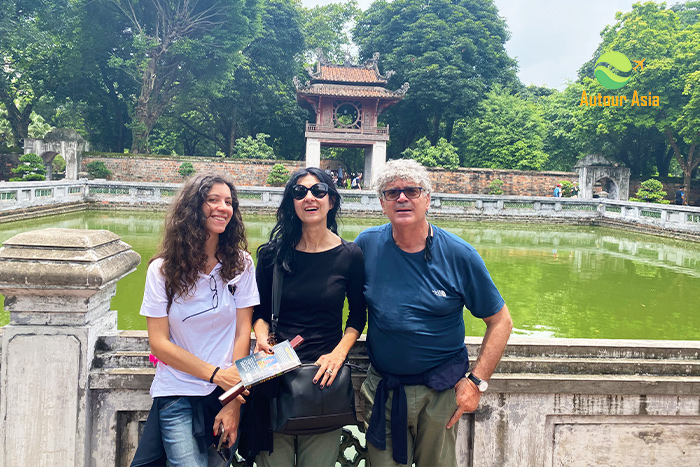
Hanoi Temple of Literature is not merely a historical site; it is a sanctuary of learning and intellectual enrichment. As the country's inaugural national university, it played a crucial role in cultivating Vietnam's scholarly elite. Today, it continues to inspire visitors, particularly students and researchers, who seek knowledge and a deeper understanding of Vietnamese intellectual traditions. This revered site is an enduring testament to Vietnam's rich educational heritage and a top attraction in Hanoi for anyone interested in the country's cultural and academic history.
Read more : Hanoi Temple of Literature
2. Ngoc Son Temple
- Address: Dinh Tien Hoang Street, Hang Trong, Hoan Kiem district, Hanoi, Vietnam
- Google Map: https://goo.gl/maps/qAac1ZGr9QZJHTRz5
Ngoc Son Temple, located on Jade Island in the heart of Hanoi's Hoan Kiem Lake, is an absolute must-see for any tourist visiting Vietnam. This iconic temple, dedicated to General Tran Hung Dao, Confucian master Van Xuong, and the national hero La To, offers a rich blend of historical and cultural significance. Visitors reach the temple via the charming red Huc Bridge, which adds to the picturesque setting.
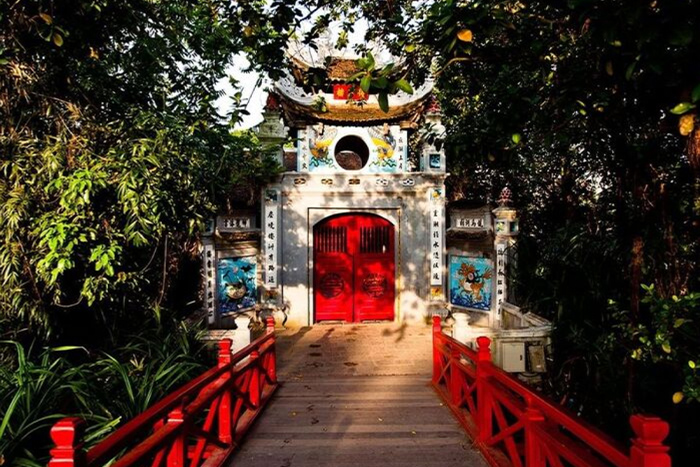
Inside the temple, tourists can explore altars adorned with statues, ancient artefacts, and intricately carved woodwork. The highlight is the preserved specimen of a giant turtle, linked to the legendary story of King Le Loi and the magical sword returned to the lake's divine turtle. The tranquil surroundings, combined with the temple's spiritual ambiance, provide a serene escape from the city's hustle and bustle.
This Vietnamese temple offers a serene retreat from the city's bustle, providing a rich glimpse into Vietnam's heritage. It's open daily, and the best times to visit are early morning or late afternoon to avoid crowds. Nearby, the bustling streets of Hanoi Old Quarter offer numerous cafes, shops, and cultural experiences, making a visit to Ngoc Son Temple a perfect start to exploring the vibrant capital.
3. Quan Thanh Temple
- Address: Thanh Nien Street, Quan Thanh, Ba Dinh district, Hanoi, Vietnam
- Google Map: https://goo.gl/maps/S61bPtpyeWHQxhGB9
Quan Thanh Temple, also known as Tran Vu Temple, one of the most famous temples in Vietnam, is a renowned Taoist sanctuary in Hanoi, celebrated as one of the Four Sacred Temples of the capital. Built in the 11th century during the Ly dynasty, it’s a renowned Buddhist temple in Hanoi dedicated to Tran Vu, the god of the sea and mountains. The temple features impressive traditional Vietnamese architecture, including a grand entrance gate, a spacious courtyard, and well-maintained gardens. Visitors can admire the detailed carvings and the large bronze statue of Tran Vu and twenty-eight constellations, which highlight the temple's spiritual and artistic significance.
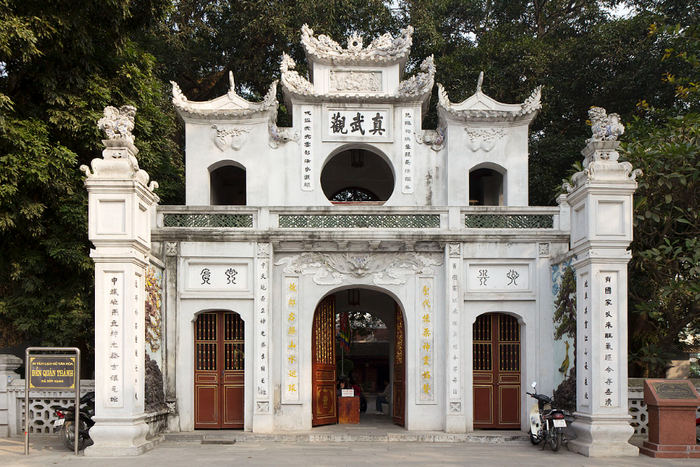
Quan Thanh Temple is a symbol of Vietnam's cultural richness and diversity. Its peaceful ambiance and historical importance make it an ideal destination for those seeking spiritual reflection, an appreciation of art, or an understanding of Vietnamese history. This sacred site invites visitors to experience its unique atmosphere and immerse themselves in the depth of Vietnamese cultural heritage.
4. Bach Ma Temple
- Address: 76 Hang Buom Street, Hoan Kiem district, Hanoi, Vietnam
- Google Map: https://maps.app.goo.gl/9fTjugAiakQq3iD69
Visiting Bach Ma Temple, located in the bustling Old Quarter of Hanoi, a revered site dedicated to the worship of the White Horse deity, a symbol of protection and prosperity, is the best answer to the question: what to visit in Vietnam? This ancient temple, originally built in the 9th century during the reign of King Ly Thai To, is one of the city's oldest and most significant spiritual landmarks. The legend behind its establishment tells of a white horse leading the king to the temple's location, indicating where the city should be founded. This divine guidance is deeply ingrained in the temple's history and adds to its mystical allure.
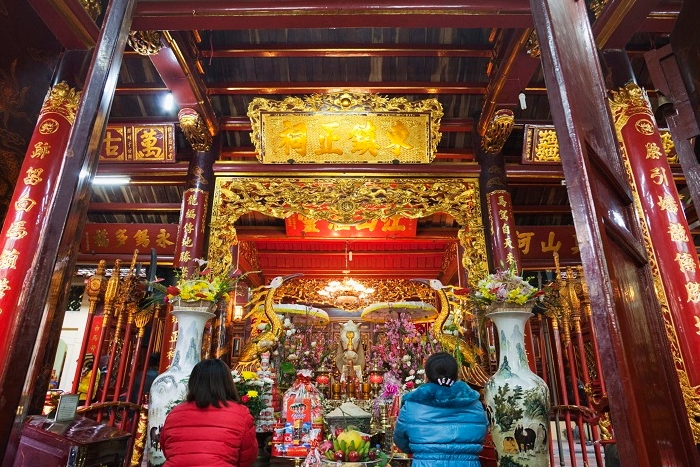
The architecture of Bach Ma Temple is a blend of traditional Vietnamese design and historical influences, featuring intricate carvings, red lacquered columns, and gold accents that exude a sense of timeless elegance. The main altar, dedicated to the White Horse deity, is adorned with exquisite statues and offerings, creating a serene and sacred atmosphere. Visitors are often captivated by the temple's rich cultural heritage and its role in the spiritual life of Hanoi. Special ceremonies and festivals, particularly the White Horse Festival, draw devotees and tourists alike, making this Vietnamese temple not only a place of worship but also a cultural treasure in the heart of the city.
Maybe you're interested in:
>>> Things to do in Hanoi for 3 days
>>> Hanoi Travel Guide
>>> Vietnam Travel Tips
>>> Things to do in Hanoi for 3 days
>>> Hanoi Travel Guide
>>> Vietnam Travel Tips
5. Quan Cong Temple
- Address: 24 Tran Phu street, Cam Chau, Hoi An ancient town, Quang Nam, Vietnam
- Google Map: https://maps.app.goo.gl/jmckGtfACE1LnnGi6
If you’re wondering what to visit in Vietnam, consider visiting Quan Cong Temple in Hoi An, Vietnam, a captivating attraction that draws tourists with its rich history and stunning architecture. Dedicated to Quan Cong, a revered general of the Han Dynasty known for his loyalty and integrity, the temple embodies traditional Chinese architectural styles with its red-tiled roofs, intricate wood carvings, and grand entrance gates.
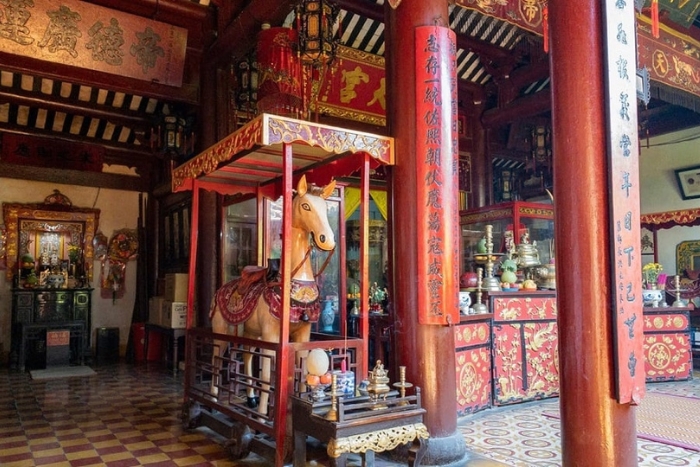
Visitors are particularly impressed by the temple's ornate altar, which features a life-sized statue of Quan Cong flanked by his loyal subordinates. The serene atmosphere, combined with the temple's historical significance and cultural richness, makes it a must-visit for those exploring Hoi An ancient town. This temple in Vietnam also plays a vital role during the annual Lantern Festival, where it becomes a focal point of vibrant celebrations, further adding to its allure.
6. Cao Dai Temple
- Address: Pham Ho Phap, Hoa Thanh, Tay Ninh, Vietnam
- Google Map : https://maps.app.goo.gl/eGc4D2L9ff3j6wvJ9
Cao Dai Temple in Tay Ninh is a sacred and mesmerising site, one of the most worth visiting among temples in Vietnam, often considered an indispensable destination for any tour of southern Vietnam. As the holy seat of the Cao Dai religion, this temple stands out for its unique blend of architectural styles, incorporating elements from Buddhism, Taoism, Confucianism, Christianity, and Islam. The temple, completed in 1955, features a striking façade adorned with vibrant colours, intricate carvings, and symbolic imagery that represent the syncretic nature of the Cao Dai faith.
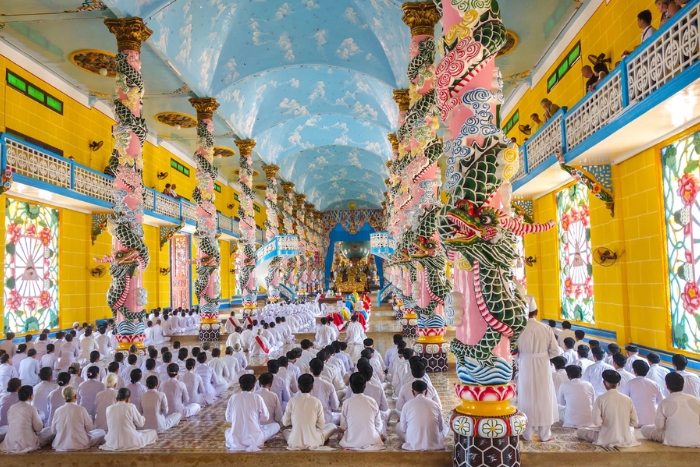
One of the most captivating aspects of this Vietnamese temple is its Great Divine Temple, or Holy See, which showcases a nine-level tower symbolising the ascent to heaven. Inside, the temple is equally impressive, with a grand hall featuring rows of dragon-wrapped pillars and a high domed ceiling painted with celestial scenes. The main altar is dominated by the Divine Eye, a central symbol of Cao Dai, representing the all-seeing wisdom of the supreme deity. Visitors to the Cao Dai Temple are often drawn by the opportunity to witness the colourful daily ceremonies, where adherents in white robes participate in prayer and chanting rituals, accompanied by traditional music make it a must-visit landmark that offers a profound insight into one of Vietnam's unique religious traditions.
III. Some useful advice for tourists to visit temples in Vietnam
- Dress appropriately: Wear attire that covers your shoulders and knees, such as long pants or skirts and shirts with sleeves when visiting Vietnamese temples. Be prepared to remove your shoes before entering certain areas of the temple, so sandals or slip-on shoes are convenient.
- Show respect: Maintain a calm and quiet demeanour while inside the temple. Avoid loud conversations, laughter, and disruptive actions to show respect for the sacred space.
- Photography etiquette: Always ask for permission before taking photos, especially inside the temple and of the monks. Avoid using flash or bulky equipment that can be intrusive.
- Be mindful of sacred spaces: Some parts of temples in Vietnam may be off-limits to visitors; respect signs and barriers. Keep the temple grounds clean by disposing of trash properly and avoid bringing food or drink inside.
By following these guidelines, you can ensure that your visit to Vietnamese temples is both respectful and enriching, allowing you to fully appreciate the cultural and spiritual richness they offer. Taking the time to learn and engage with the traditions and customs will enhance your experience and leave you with a deeper understanding of Vietnam's profound heritage. If you want to know more useful information about Vietnam travel, don't hesitate to contact AUTOUR ASIA - best travel agency in Asia.
We suggest you refer to the following circuits:
>>> Vietnam itinerary 14 days
>>> Vietnam Tour 17 days
>>> Vietnam Packages Tours
>>> All our Vietnam Tours
>>> Vietnam itinerary 14 days
>>> Vietnam Tour 17 days
>>> Vietnam Packages Tours
>>> All our Vietnam Tours
Henry
5.0
Excellent
What do you wear to the Vietnamese temple?
What to wear in Vietnam? One way to plan ahead to Vietnamese temple is to dress in layers and bring a scarf or shawl along, no matter where you go. When visiting temples, capri pants and long skirts are preferable to shorts, although men can sometimes get away with wearing long shorts.
Serena
5.0
Excellent
What is the etiquette in Buddhist temple?
You'll enjoy the experience even more if you remember the following rules. Show respect: Turn off mobile phones, remove headphones, lower your voice, avoid inappropriate conversation, remove hats, and no smoking or chewing gum in temples in Vietnam.
Related travel guide
Other similar articles
CUSTOMIZABLE BY LOCAL EXPERTS
Personalized trip at the original price!
REFUND GUARANTEE
We believe in our work and promise to give you money back.
GOOD PRICE / QUALITY
95% satisfied more than expected!
24/7 LOCAL SUPPORT
We are always available online to provide assistance at any time.
Most read articles
Autour Asia is highly recommended on
Embracing the mission of "Satisfied more than expected" and providing authentic experiences, we have received numerous recommendations on reputable travel forums:























